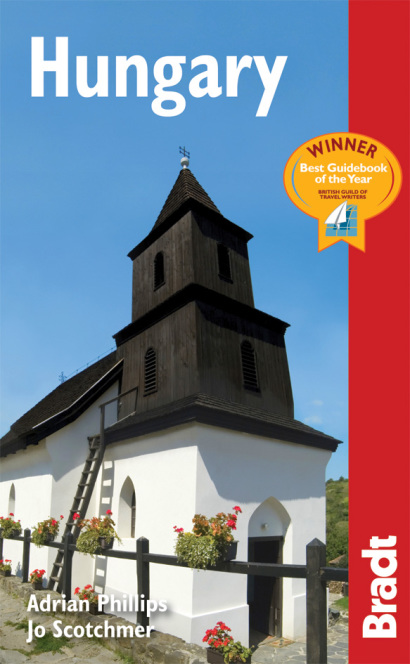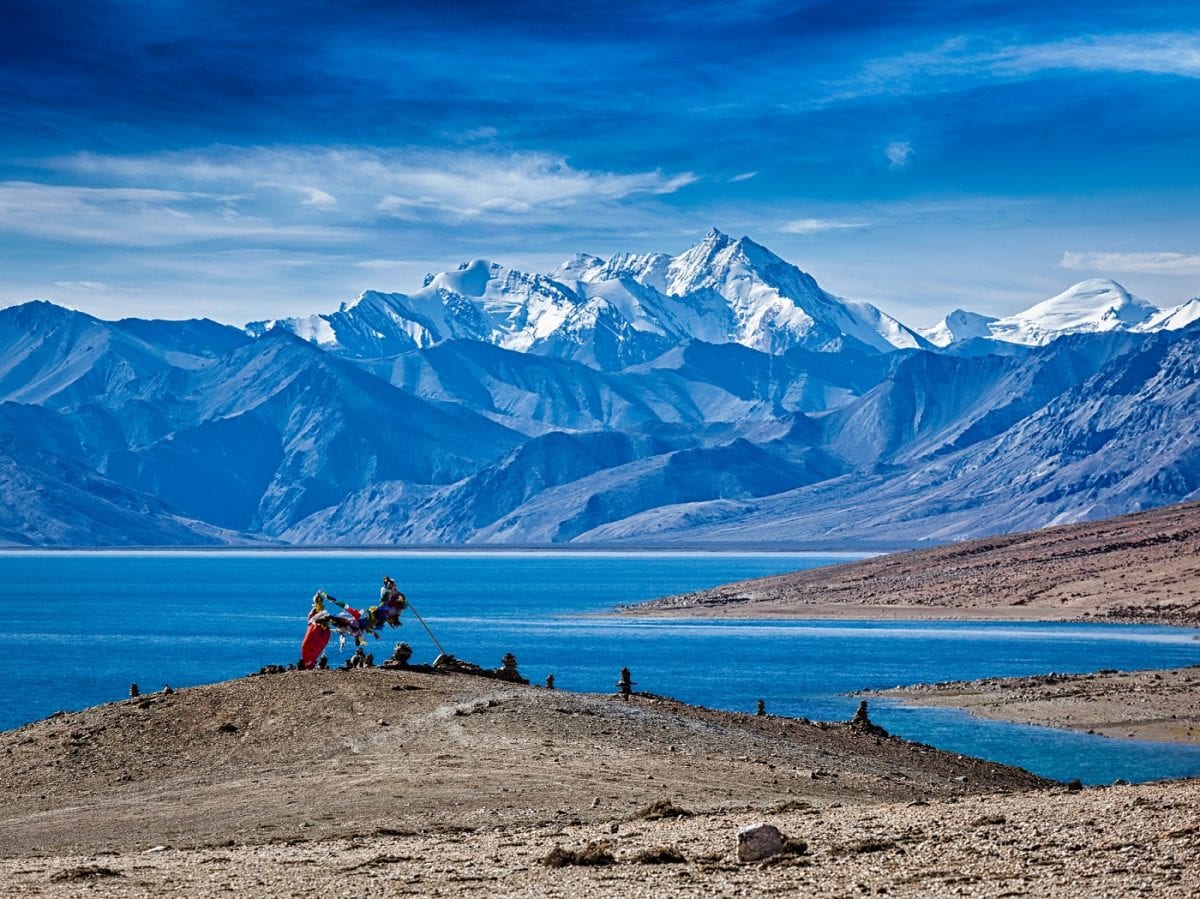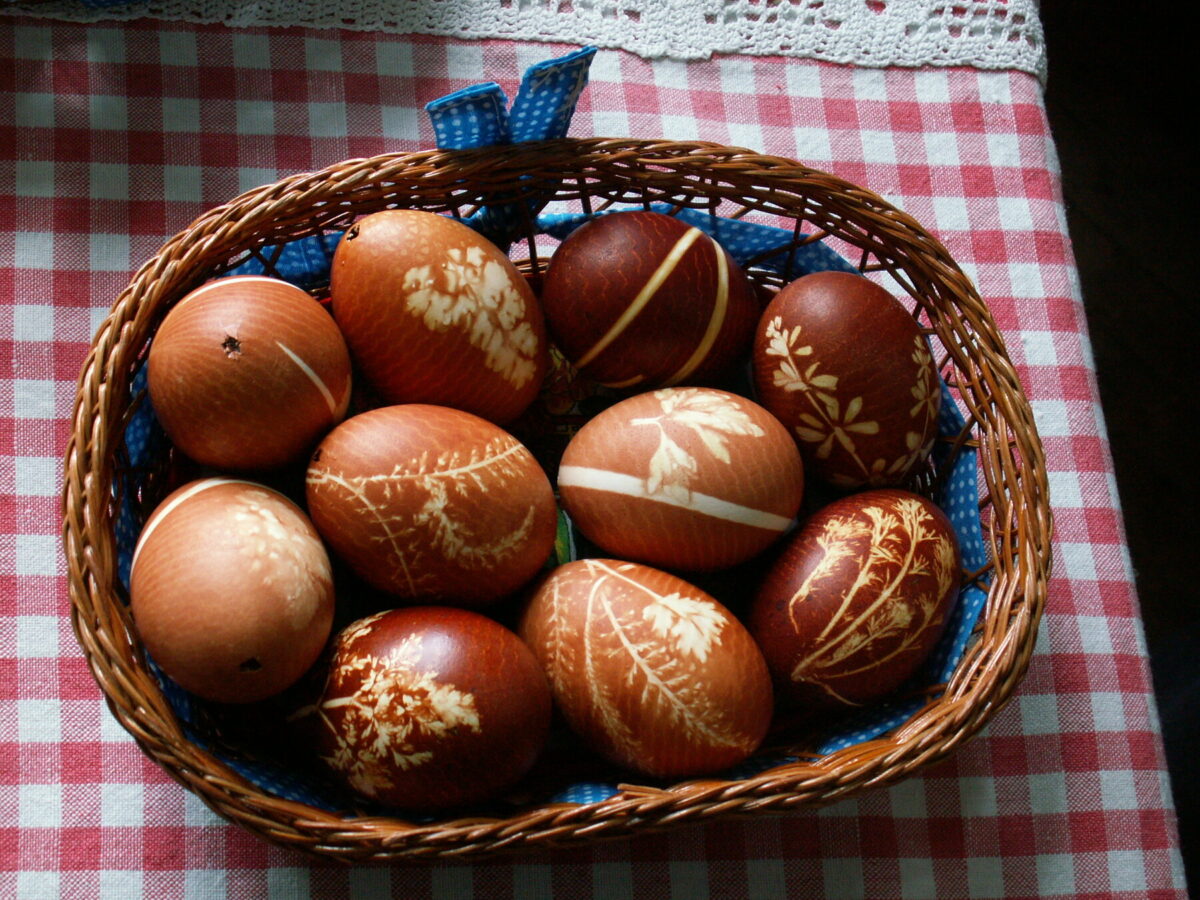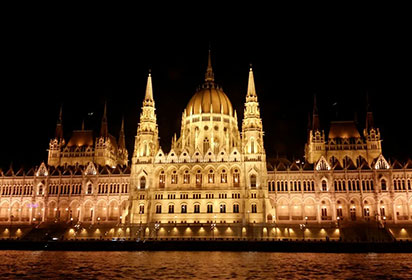Diversity and accessibility come together in Hungary; there’s something here for everyone and it’s never far away.
Adrian Phillips & Jo Scotchmer authors of Hungary: The Bradt Guide
Landlocked in the centre of the continent, Hungary’s European culture has a hint of the exotic. Architecturally it is a gold mine; from Baroque churches and Romanesque abbeys to Gothic buildings and Turkish baths, the country’s structural heritage is a canvas of one repeatedly repainted.
Its food is also at a European crossroads; influenced by the kitchens of France, Serbia and Turkey, its cuisine is so much more than just than a steaming bowl of goulash. And don’t forget the people – a rare and intriguing breed who look upon the gloomier things in life, Hungarians are fiercely patriotic and take great pride in their heritage.
Budapest’s charms are no longer a secret. It really does have it all: spectacular architecture, award-winning cultural festivals, Michelin-starred restaurants, historic thermal baths and friendly hotels. But venture away from the world-famous sights of the capital, and you will be rewarded.
For nature-lovers, the lush walking trails of the Nothern Uplands and pristine waters of Lake Tisza offer ample opportunity for birdwatching. For those who love wine, you’ll find big-bodied reds and crisp whites in Eger’s Valley of the Beautiful Women. And, for those who simply want to soak up some culture, Pécs’, with its spectacular cathedral and museums, has an intellectual and cultural energy that is truly palpable.
For more information, check out our guide to Hungary:
Food and drink in Hungary
Food
Hungarian cuisine (Magyar konyha) has been influenced by the kitchens of Serbia, France and Turkey; the Renaissance court of King Mátyás introduced Italian ingredients like garlic, onion and dried pasta; the Germans and Austrians muscled in during the Austro-Hungarian period with their cream-filled desserts, sauerkraut and dumplings. All these tastes add nuances to a no-nonsense, homely tradition of peasant cookery.
Pork became a staple of the Hungarian diet after the Turkish invasion, when the Muslim occupiers left pigs wholly to the natives. Sour cream is handsomely applied to soups and sauces, as well as dishes of meat, cabbage and sweet pasta. Vegetable accompaniments are pickled or from the freezer, and salads plate-edge afterthoughts. The vegetarian diner may feel put upon in traditional restaurants, where the choice is often restricted to fruit soups and cheese or mushrooms in breadcrumbs. Cumin, caraway, black pepper and marjoram are frequently used for seasoning, but when you think Hungary it’s red (piros) paprika that sets the tastebuds tingling. Probably introduced from Spain in the 16th century (although not widely used until the 19th), it imparts vivid culinary colour, and ranges in taste from sweet and fruity (édes) to fiery (eros), the latter proffering a kick like a hussar’s horse. And woe betide he who gets between a Magyar and a piece of fresh bread (kenyér); it is regarded as the greatest of feasts.
While many busy Hungarians may just grab a roll on the run, if they greet the day properly then it is early and with a breakfast (reggeli) of open sandwiches. Salami (szalámi) or dried, chorizo-like sausage (száraz kolbász), ham, cheese, yellow pepper and tomato are eaten with white bread. The weekend may see omelettes on the table, while at Easter there is gammon-like ham with boiled eggs and horseradish. The reviving morning brew is hot (often black) coffee or tea with lemon (not milk).
Lunch is the main event, and comprises two courses. The first is likely to be soup (leves). Freshwater lakes like Balaton provide the specimens for fish soup (halászlé) – a customary dish on Christmas Eve. Chicken soup (tyúk húsleves) is packed with vegetables and light pasta (similar to Italian vermicelli), while fruit soup (hideg gyümölcsleves) is a refreshing summer slurp, flavoured with cherry or strawberry, topped with cream and served cold. The smoky, meaty kidney-bean soup (jókai bableves) can be gorgeous. The international superstar is, of course, goulash (actually gulyás, and pronounced ‘gooyash’), strictly a soup rather than a stew, and containing beef or pork, pinched dumplings, vegetables and the ubiquitous paprika. Cooked in a cauldron (bogrács), its roots can be traced to the country’s nomadic ancestors. The meaty Hortobágy pancake (Hortobágyi húsos palacsinta) is a speciality of the Great Plain; seasoned minced pork or poultry is folded into thin pancakes and baked in a sauce of paprika and sour cream. Please don’t miss this one – it shades the number one spot on our Hungarian-dish wish list.
The second course is invariably a meat-based rib sticker, usually served with weighty side dishes including egg dumplings (galuska or nokedli), couscous-type pasta (tarhonya), potato croquettes (krokett) and rice. A traditional stew (pörkölt) might be concocted from any of the main meats, but our vote goes to that with chicken (csirkepaprikás) – creamy, golden as toffee, and occasionally with the coxcomb thrown in! Other popular choices are stuffed cabbage (töltött káposzta) or pepper (töltött paprika) filled with minced meat, a piece of the earthy-tasting pike perch (fogas), and a plate-sized slab of Wiener schnitzel (bécsi szelet). The latter is often eaten for Sunday lunch.
Pudding (édességek or desszertek) requires a healthy appetite and a sweet tooth. Any room for a cake, an ice cream, a strudel or a crêpe? At times savoury becomes sweet; túróscsusza is a hot pastry with ricotta, sour cream and – believe it or not – pork crackling. Pastas, too, are familiar dessert dishes. Rétes is an Austrian strudel filled with either fruit, walnut, peppery cabbage or poppy seeds and ricotta, while walnut cream and chocolate sauce is the heavenly mix in a Gundel pancake (Gundel palacsinta).
Drinks
Much beer (sör) is imported from the Czech Republic or brewed under the licence of foreign companies like Tuborg and HB, but Hungarian beers are deserving of attention. They might be bottled or on tap, and fall into two types – lager (világos) and brown (barna), the latter similar in colour to English bitter but with a sweet flavour. The leading breweries are Dreher, Soproni and Borsodi, the first marginally our preferred choice, while other regional brands can be found in the supermarkets. The word for ‘cheers!’ – egészségedre – is a mouthful at the best of times, but becomes a particular trial after a drink or two.
It is said that Hungarians can be divided into the few who produce wine and the many who would dearly love to. For much of the 20th century, you’d be forgiven for thinking the amateurish majority had been let loose on the vineyards. There was a massive decline in quality behind the Iron Curtain; vineyards were neglected, fine sites abandoned, and state co-operatives devoted themselves to mass production. During the 1980s, Hungary’s main export, Bull’s Blood, became a byword for vinegar; the Soviets were the sole bulk buyers. However, change has been rapid since the advent of privatisation. Joint ventures with foreign vintners and investment in technology have resulted in some fine wineries, many of them family-owned.
Health and safety in Hungary
Health
Generally the standard of public health in Hungary is good, the tap water safe to drink and no vaccinations are legally required. However, it is wise to be up to date with routine vaccinations such as diphtheria, tetanus and polio. Hepatitis A should also be considered.
If you are planning to visit deep-forested areas outside the capital, consult your doctor about getting immunisation against encephalitis, which is carried by forest ticks (kullancs). Take precautions by using tick repellents, wearing long-sleeved clothing and a hat, and tucking trousers into boots. After a day in the forest it is important to check yourself for ticks, or get someone else to do it for you. For those travelling with children, concentrate particularly on checking their hair. The other primary irritant is the mosquito, which whines around the riverside on summer evenings. Cover exposed skin with a DEET-based insect repellent (rovarirtó) and they’ll feast on some other suckee.
For those who are going to be working in hospitals or in close contact with children, hepatitis B vaccination is recommended. Pre-exposure rabies vaccine (ideally three doses given over a minimum of 21 days) should also be considered for anyone who is specifically going to be working with animals.
Safety
Happily Hungary is a safe country with a low rate of violent crime. However, like many other European countries, incidents of pick-pocketing, mugging, car theft and overcharging with threats are sadly on the increase. The bulging tourist wallet is inevitably at greatest risk, so it is wise to stay vigilant when travelling on public transport, strolling in busy and built-up areas, shopping in markets and malls, and relaxing in restaurants and bars. As a general rule, don’t let your belongings out of your sight, try not to flash around valuable items and make use of your hotel safe.
Never walk the streets with large sums of cash, or – as we learnt to our cost – leave your cellphone in an unzipped shoulder bag as you peer at the bus timetable. There have been occasional instances of criminals going to more extreme lengths to extort money from tourists. Examples include conmen posing as policemen and demanding cash (if in any doubt, ask for the ‘officer’s’ credentials and insist on being taken to a police station with access to a translator), and thieves posing as motorists in distress, flagging down fellow drivers for assistance before stealing from them and driving away in their cars (be cautious about stopping to help apparent breakdowns). Theft of cars and the possessions inside them is not uncommon, so don’t tempt opportunists by leaving things of value on the seats.
Gentlemen, if an attractive young woman approaches and asks you to join her for a drink, consider the possibility that she is drawn by more than your irresistible masculine charms. Unwary, strutting men have lost both their swagger and their swag when, after tripping over their tongues into a seedy joint with a ‘consume girl’, they have been forced by burly bouncers to pay an extortionate price for the drinks.
On a more mundane level, check your bills in restaurants and bars carefully for ‘mistakes’ in the maths. Never order from a menu that does not display prices alongside its fare. Always use a recognised taxi firm, and agree a price or check the meter is cleared before climbing in. And resist dealing with unlicensed moneychangers in the street.
We must stress again that by Western standards Budapest is extremely safe, and you are unlikely to feel threatened. Please don’t have nightmares, do sleep tight. For up-to-date security information, check the Foreign and Commonwealth Office website at www.fco.gov.uk.
Female travellers
There is a typical central European machismo to Hungarian men, and they can hold attitudes that many in the West would consider sexist. Such thinking tends to manifest itself in high-blown compliments rather than anything more sinister. Women will find men unafraid to ‘check them out’ as they pass in the street and perhaps less inhibited in approaching them in bars than in more reserved cultures such as Britain; however, provided women take sensible precautions they should encounter no harassment.
Travel and visas in Hungary
Visas
European Union (EU) nationals, including those from Britain, may visit Hungary as indefinite tourists providing they have valid passports; visitors from France, Germany, Italy and Spain require only a national ID card. EU nationals need a European Economic Area resident-citizen permit if staying longer than three months.
Apply at the local regional agency of the Hungarian Immigration and Nationality Office before the last two weeks of your stay. Tourists from all other European countries (excluding Albania, Turkey, Macedonia and Bosnia and Herzegovina), the USA, Canada, Australia and New Zealand can visit without a visa for up to 90 days.
Travellers wishing to exceed a 90-day stay should apply for a visa from their country’s Hungarian consulate and allow several weeks for it to be processed. More information is available on the website of the Hungarian Immigration and Nationality Office.
Getting there and away
By air
As with air travel to most European destinations, ticket prices to Hungary are at their highest during the summer period (Jun–Aug), and at Christmas and New Year. Costs may also rise during city festivals, and especially during the Hungarian Grand Prix.
The cheapest season is winter (Nov–Mar). Shop around for cut-price flights and last-minute bargains on the internet (try www.expedia.com, www.travelocity.com, www.lastminute.com and www.cheapflights.co.uk). Budapest’s Ferihegy International Airport is currently the only entry point for travellers from most countries.
For a short time, Ryanair was offering flights from the UK to a small airport – formerly a Soviet airbase – 15km from Keszthely at Lake Balaton. Those flights have now ceased (with no current plans to revive them), although Lufthansa is running services from Germany.
By train
Unless you’re planning to make the train ‘a feature’ of your trip – perhaps by booking with a specialist tour operator – travelling from the UK to Hungary by train is only worth the time and effort if you’re planning a round-Europe trip, would like to stop off along the way, or are afraid of flying. Flights with budget airlines are generally considerably cheaper than return rail tickets.
The journey from London takes 22 hours (including the three-hour journey on Eurostar), and you can travel via Cologne and Munich, Frankfurt and Nürenberg or Paris and Vienna. Tickets are usually valid for around three months, allowing you to get off to explore along the way (although you can’t depart from your booked route).
For information on crossing the Channel from London, contact Eurostar (08705 186186; www.eurostar.com). Rail tickets to Budapest can be booked through the Rail Europe Travel Centre (08448 484064; www.raileurope.com), who can also help to plan your trip. Alternatively, you can contact Trains Europe (0871 700 7722; www.trainseurope.co.uk), a leading supplier of European rail tickets (including, they claim, tickets Rail Europe can’t provide) that can also offer advice on itineraries and routes.
By car
The overland drive from the UK to Budapest would certainly make an epic of a road movie – all 1,684km (1,047 miles) of it – but there’s a certain romanticism and some wonderful scenery. Once on mainland Europe the easiest route to Budapest is via Ostend, Belgium, Cologne, Frankfurt and Vienna.
On a good day the journey should take around 17 hours but, obviously, this doesn’t take into account food (and ablution) stops, sleep breaks, traffic problems, border queues, etc. See www.michelin.com for a detailed route planner. It’s important to keep to hand your driving licence, vehicle insurance and registration documents (as well as your passport), and to display your country-identification letter on your vehicle.
It is vital to take out adequate breakdown cover in case the unthinkable happens. The AA (0800 085 7253; www.theaa.com) operates a European Breakdown Cover policy that will protect you on your trip. Finally, be aware that tolls and high fuel prices in mainland Europe can considerably inflate your anticipated expenses.
Getting around
Public transport within Hungary is efficient, reliable and cheap; most villages and towns are accessible by either train or bus (although certain very remote areas – such as the extreme northeast – are most readily navigated by car). Many settlements can be explored by foot but public transport within larger towns is also excellent.
Buses, trolleybuses and trams run throughout the day until around 23.00; tickets can be purchased from newsagents, street stands and some hotels, and should be stamped in the punching machines aboard the vehicles. There are no scheduled internal flights.
Note that EU members over the age of 65 can travel free on public transport anywhere in Hungary – just show your passport. (You’ll need to pay a very small reservation fee when buying tickets for express trains, which have to be booked in advance.)
By train
Trains operated by the Hungarian state railway company MÁV (Magyar Államvasutak) certainly can’t be described as modern, but they are comfortable enough. There are first- and second-class carriages, and often a buffet car; you must buy a separate ticket for your bike (costing an additional 25%), and place it in the front or back carriage (if there isn’t a specified area set aside for cycles).
Budapest is the central hub for all the major rail routes that link the main cities and towns, and in some cases it is quicker to travel via the capital – even if it adds distance to the journey – than taking secondary branch lines where services are slower. InterCity trains (IC) are the quickest services, offering direct routes that stop only at major towns and cities.
The InterCity Express (EX) also only halts at main settlements, but doesn’t get up the same speed on the way. The ‘fast trains’ (sebesvonat and gyorsvonat) cost around 10% less than Express trains, and stop more frequently. Avoid the ‘slow trains’ (személyvonat) unless you only have a short distance to go – they don’t miss a station, calling in at even the piddliest little places, and the fares are no cheaper than for the fast trains.
By bus
Buses reach the nooks and crannies that trains cannot, and can be a quicker alternative to the railway branch lines (although they are a touch pricier than 2nd-class train fares); they are often the only viable option in remoter regions of the Great Plain and Southern Transdanubia.
They are generally comfortable, with adequate legroom, and on long journeys the driver will stop every few hours to allow passengers to stretch their legs. In towns and cities, there are usually separate stations for local and inter-city services. The timetables posted in the bus stations are inevitably confusing. Volánbusz operates most of the domestic buses to and from Budapest as well as the majority of the regional lines (see www.volanbusz.hu for up-to-date timetables).
By car
Hungary is in some ways a walk in the park when you can drive in a car; the country’s furthest reaches are within five or six hours of Budapest. The government has recently spent considerably on improving major roads and extending motorways. It’s not all dreamy, though.
Beyond the main routes, singlelane carriages can prove frustrating when stuck behind a choking Trabant held together with sticking tape and, at the other end of the spectrum, impatient boy racers can be a pain in the rear bumper. Hungarians tend to treat blind bends as overtaking opportunities too, and this can seem hairy at times.
If you are involved in an accident, report to the police immediately before contacting Hungária Biztosító (VII Budapest, kiraly u. 59/b;1 237 2372) – part of the Allianz group – a company that helps foreigners with insurance claims. Most petrol stations accept credit cards and sell unleaded fuel, and some are open 24 hours. There are often pump attendants on hand, and it’s polite practice to give them a small tip.
When to visit Hungary
Hungary has somewhere offering something all year round, although in winter it is difficult to look beyond the biggest cities or the ski slopes of the Mátra Hills (which are, in fairness, rather feeble by comparison with alpine resorts elsewhere). The cold settles in from the end of October until the middle of March, and bites in December and January when the sun pushes off early at 16.00. However, don’t discount the winter period entirely for it’s a frosty heart that turns from the romance of Budapest with snow under foot and Christmas markets selling piping mulled wine. Just bring your scarf and gloves.
Come in spring or autumn if you want to avoid traipsing in the wake of beetroot-red gaggles of tourists, and to enjoy cultural festivals in Budapest and other towns and cities. These are the seasons to watch nature by, when the climate is warm enough for strolling (although it can be wet between April and mid May and in November) and the play of light beautiful.
Autumn is when the grape is harvested and when countless cranes fill the skies at Hortobágy. Furthermore, hotels have not yet hiked their prices for the peak season. That of course comes in summer, which is long and hot (with temperatures hitting up to 32°C). Landlocked they may be, but Magyars adore their water, and you can choose from thousands of outdoor lido-style bathing complexes and swimming areas (strands). Locals traditionally ship out of Budapest and other large cities in the sticky months of July and August, many heading to Lake Balaton (whose southern shore in particular heaves with bodies).
What to see and do in Hungary
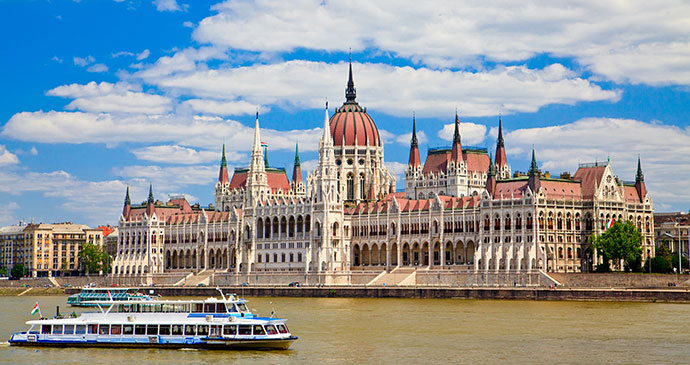
Budapest
Great cities are forged from moments of tragedy as well as triumph, but Budapest has seen more than its fair share of blood and bullets. Traditionally, when Hungary dropped the toast it landed buttered-side down.
The Turks strutted here in the 16th and 17th centuries, Austria ruled during the 18th and 19th, and the 20th century saw the country lurch from one terror regime to another. The citizens did not subject meekly; the capital has witnessed several revolts and some ding-dong street battles, and the nation’s revered heroes are those who’ve fought for freedom.
Nowadays, however, Hungarians are in charge, and the only gangs of foreigners are coach parties. Tourism is thriving in the capital, and has boomed further since entry to the EU. Budapest is big enough to take it; one of the city’s strengths is the elbowroom around its sights. While there are quaint narrow streets on Castle Hill, Budapest is characterised more typically by the broad and the bold.
These are features of nature, such as Buda’s craggy hills and caves, and the sweeping river; they are also features of architecture, such as Pest’s Historicist and Art-Nouveau mansions and Parisian boulevards, which replaced the medieval and Baroque during 19th-century expansion. Another strength is the diversity of attractions. The city is significant both for its museums and its nightclubs, for its opera house and its contemporary music festivals; it suits both the flâneur and the hill walker.
For all the exoticism of its Turkish baths and the impact of its communist past, this is a cosmopolitan capital that has always looked longingly westward. However, with the odd smoking Trabant, rumbling tram, and flowerselling néni comes destinational bite, and a flavour quite unique. You can find out more about the Hungarian capital in this travel guide to Budapest.
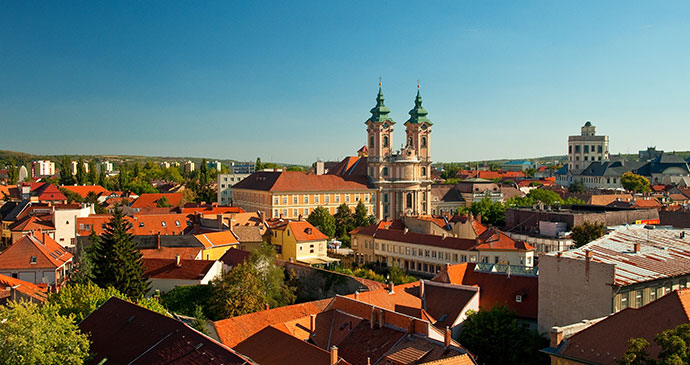
Eger and the Mátra Hills
Resting in the valley of the River Eger, between the Mátra and Bükk ranges, Eger – from the Latin word ager (earth) – is one of the country’s charmers, an enchanting town of cobbled streets, Baroque buildings and Bull’s Blood (Egri Bikavér). It is easy to see why visitors flock here and coo. But Eger is not just a pretty face; its defiance of Turkish force in 1552 was immortalised in the 1901 novel Egri Csillagok (Eclipse of the Crescent Moon) by Géza Gárdonyi (1863–1922), and its citizens became linked in the Hungarian mind with the most spirited of patriots.
Settled by the Magyar tribes, Eger was made a bishopric by King István in the 11th century. Its rise as a significant centre of Renaissance culture was curtailed by the Turks. The womenfolk of the town famously fought shoulder to shoulder with István Dobó’s 2,000 soldiers in repelling the first siege in 1552. The victory over a far superior force was acclaimed around Europe, and effectively stalled (temporarily) the spread of the Ottoman empire. It was also during this struggle that Dobó’s troops are said to have been issued with wine – which the attackers mistook for bull’s blood – to assist them in screwing their courage to the sticking place. There was considerably less backbone on display when the Turks returned in 1596, however, and a defending garrison of mercenaries surrendered with barely a whimper (excepting, it is hoped, the trumpeter, who was apparently a deepchested Englishman). Despite a promise of safe passage, the Walloons (who had repopulated the town after the Mongol invasion in 1241) among the many foreign fighters were slaughtered mercilessly in revenge for their part in an earlier massacre of Ottomans living in nearby villages. Today a solitary minaret and a few bath stones are the only reminders of the occupation that lasted until 1687.
Eger was heavily involved in the War of Independence led by Rákóczi, and the Habsburg Emperor Leopold crippled some of the castle fortifications to ensure it couldn’t be used by freedom fighters. There was swift development of the town during the rest of the 18th century, with the construction of private houses and ecclesiastical buildings. Look down from the fortress at the many church steeples spiking the skyline and you’ll understand why it earned the nickname ‘the Hungarian Rome’.
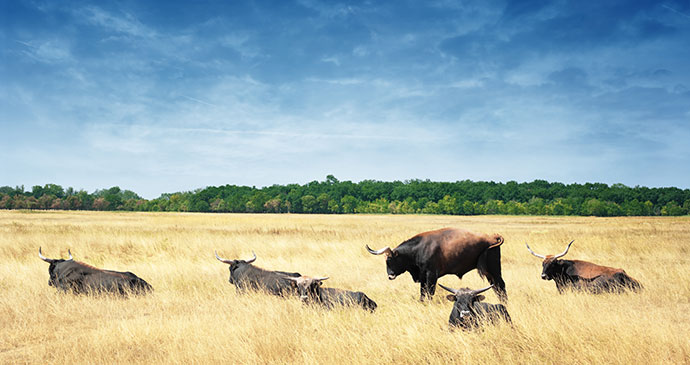
Hortobágy
Hortobágy, 25 miles west of Debrecen, is a tiny village in the thick of the vast Hortobágy National Park. This area looms very large in Hungarian folklore and poetry, and the image of horsemen in traditional garb galloping across the wide plain is as much a part of the country’s identity as goulash and Bull’s Blood. The place drips with romance, the legends alive from the days when cattle herders, shepherds and cowboys were abundant on the puszta. There are homesteads, barns and longhandled shadoof-like wells (gémeskút); ancient burial mounds (sírdomb) are also conspicuous when they break the pancake-flat landscape. A recurrent phenomenon recorded in literature is the appearance of ghostly forms here, from broad cities to solitary human figures. These mirages (known as délibáb) are said to form during muggy summer days, when layers of humid air with different temperatures come together. The tourist industry has very much hitched its wagon to the Hortobágy’s mystique; be prepared for the ubiquitous overblown horse shows and busloads of tourists ushered in for packaged versions of old-style Hungarian living.
Although Hortobágy includes the largest area of grassland in central Europe, it also has its marshy swampland. Hortobágy village is the place to start your exploration, and is where the majority of the restaurants, hotels and facilities are located (although most visitors come on day trips). Animal breeding and keeping is one of the prime occupations at Hortobágy, and it is famous for its animal park. The animals presumably keep a wary eye on the Hortobágy Csárda across the river, which dishes up some of the Hungarian special breeds for eating. Another classic Hortobágy site is the Nine-Arch Bridge, where the Bridge Festival is held each year.
This is horse country, and riding schools abound; for the less active, there are carriage tours too. Otherwise the national park is full of walking paths and birdwatching areas, and is best visited in the warmer months. Few come in winter, but if you do, be prepared for biting winds blowing across the flat landscape. An admission ticket is required to visit a few protected areas of the park (j900Ft/day from the visitor centre), including some cycling routes, and some others are only accessible with a guide (contact a specialist tour company).
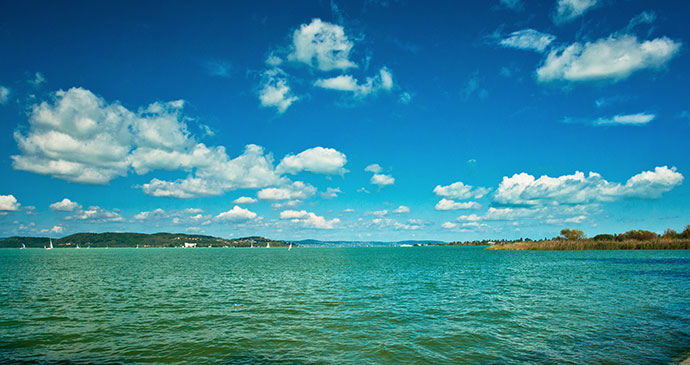
Lake Balaton
The ‘Hungarian sea’ in the middle of Transdanubia is where Hungarians come to play. They’re not the only ones. During the communist period, the lake represented a convenient meeting place for those divided by the Berlin Wall, and Germans continue to provide a decent chunk of the tourist revenue. With a length of 77km and a total area of 600km2, Balaton is the largest lake in central Europe, and its shallow depth (particularly on the southern side) – on average, just two–three metres – means both that it is relatively family-friendly and that it warms up quickly in the sun. The water harbours ample stocks of fish such as carp, bream and the native fogas (pike-perch), and is a popular place for windsurfing and rowing. Motorboats are prohibited, so you will not find yourself swamped in a waterskiier’s wash; instead wakeboarding – where the skiier is pulled around a circuit by a mechanised pulley – is very much de rigeur.
There’s a distinct north-south divide where the lake’s concerned. The southern shore is the favourite with the water-baby masses intent on sunworshipping, soaking and wakeboarding, and where the real concentration of hotels, bars and clubs is to be found. The southern resorts attract those with young children and the party crowd, and Siófok – stretching for a full 15km – is the brash leader of the pack. On the other side of the lake, the reeds, volcanic hills and cooler water make for an atmosphere less fevered: Keszthely is a university town that has a life beyond the tourist season; Balatonfüred has always taken its water with a graceful air; Tihany and Badacsony have stunning scenery and wonderful walking terrain. The northern side also boasts the best of the wines.
It used to be the case that the main season at Balaton lasted over three months, and the water is certainly a pleasant enough temperature in late spring and early autumn. However, the hotels and restaurants have been flogging the cash cow with increasing severity, and it is noticeable that the season appears to have narrowed as many potential visitors look for cheaper beach holidays elsewhere. Despite that, the most popular resorts heave with bodies in July and August, and you’d be wise to come outside those months if you can possibly help it.
Balaton is easily reached by train from Budapest Déli, and by bus or train from other towns in Transdanubia. Buses and trains are convenient links between resorts on the same shore, but the ferry is the way to go if you want to get to the other side – indeed even if you don’t, it’s a pleasant way of viewing the lake from a different angle. From April until October, ferries for foot passengers travel a route between Siófok, Balatonfüred, Tihany and Balatonföldvár, and between Fonyód and Badacsony; during the high-season months these run more often, and there are additional services to other resorts around the lake. There is only one crossing available for cars, that between Tihany and Szántód.
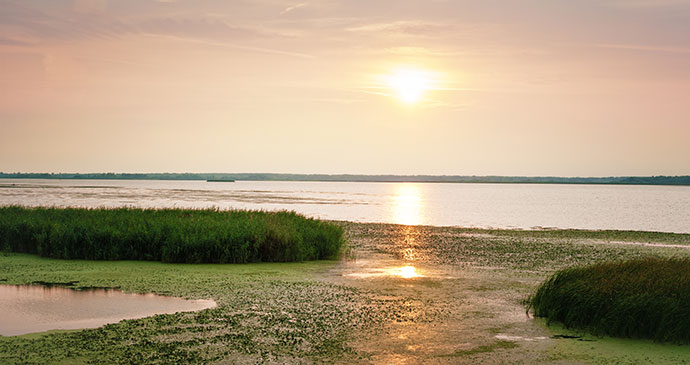
Lake Tisza
Lake Tisza is the place for those interested in fish, birds and nature photography. It was created in the 1960s and ’70s, when the River Tisza was dammed as part of the development of an irrigation system on the Great Plain. A happy by-product, it was hoped, would be a lake to rival Balaton. Lake Tisza spans 127km², and is treasured for its pristine natural environment, water-chestnut fields, mass of lily pads, winding channels surrounded by lush flora, and thriving birdlife. Two-thirds of it comprises significant wetland areas best visited in small boats capable of navigating the dozens of narrow courses. Scores of small islands, dead river arms and marshes make the lake popular with anglers, the experienced among whom know the deep or shallow points, the portions where catfish lurk and where carp are abundant. Indeed, it’s claimed that there are more than 50 types of fish in the Tisza river and lake, which are stocked to keep supplies plentiful. Because the river runs through the lake, there are also sections of choppy water that are ideal for water sports.
The lake can be divided into three parts. That north of Highway 33 is a bird reserve and part of Hortobágy National Park, as is the middle portion with its giant white water lilies and colonies of heron and cormorant that can be visited by following established trails (many of which are barred to motorboats). Other parts of the lake (the Sarud and Tiszafüred basins and the southern Abádszalók section) are where the splashing and sporting takes place.
Those who want to avoid the crowds of Balaton come here instead. Bird lovers delight in nearly 150 species of bird nesting around the lake, and generally visit during the months between April and October. Note that it is forbidden to approach nests during the hatching period in April and May. Besides bird watching, the lake’s shores are popular with cyclists, horse riders, boaters, fishers and sunbathers. Since the last edition of this guidebook, the tourist infrastructure has developed significantly around the lake, and it’s somewhere that will genuinely reward ‘outdoorsy’ types.
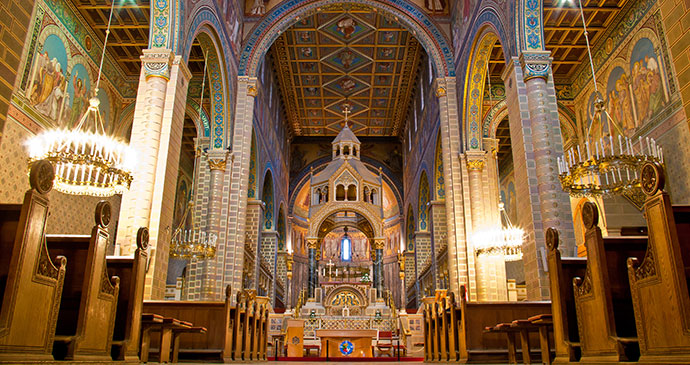
Pécs
It would be a cantankerous soul who didn’t like Pécs, a shifty sort who’d tell you that right was left and red was green before wriggling out of paying his bar tab. A man not to be trusted, you understand. Once you pass through the featureless modern suburbs, you’re greeted by a wonderful city that combines old-world charm with contemporary vibrancy, one that contains a premier cathedral, a host of conveniently placed museums and some worthy restaurants, and that is atmospheric by night and friendly by day. You’ll see in a shot why it is second only to Budapest on the tourist itinerary.
Summer lingers long in Pécs, which is shielded from northern winds by the Mecsek Hills and wallows in a sub-Mediterranean microclimate. It’s no surprise that the Romans felt at home here, establishing a town called Sopianae that was by the 3rd century one of the administrative centres of the province of Pannonia. They cultivated vineyards and fruit trees on the southern slopes, a sweet and lasting legacy that in the 15th century inspired the humanist poet Janus Pannonius to trill (in Latin) about the wonders of the late-blossoming almond trees. As the city grows and houses creep up the hillsides, viniculture is less of an enveloping presence than it once was, but vines are still harvested to the east and west of the centre, and older residents refer to themselves as tüke (a word deriving from the Hungarian for ‘vinestock’).
In 1009 King István made the town an episcopal see, and Lajos the Great opened the country’s first university in 1367, when it became a stronghold of Hungarian Renaissance culture. Ottoman occupation had a significant impact; while other settlements during this period were often left to rot, Pécs developed into a thriving oriental centre of commerce and academia. The city held 17 mosques. The residue of this Turkish influence is clearer in Pécs and its architecture than anywhere else in Hungary. Damage was heavy during the fight to remove the Turks, but the city rose again on the shoulders of vintners, coal miners digging in the Mecsek, and leather workers continuing an industry imported by Balkan immigrants. Factories producing luxury goods sprouted, among them Hamerli Gloves, Angster Organ and Zsolnay Ceramics. After the reshaping of borders through the Treaty of Trianon, Pécs’s traditional place as a hive of learning was restored when the Hungarian University of Arts and Sciences was moved here from Pozsony (Bratislava) in 1921; in the 1970s, the city’s ‘Museum Street’ was established. The fresh intellectual and cultural energy is palpable, particularly when festivals are in full swing.
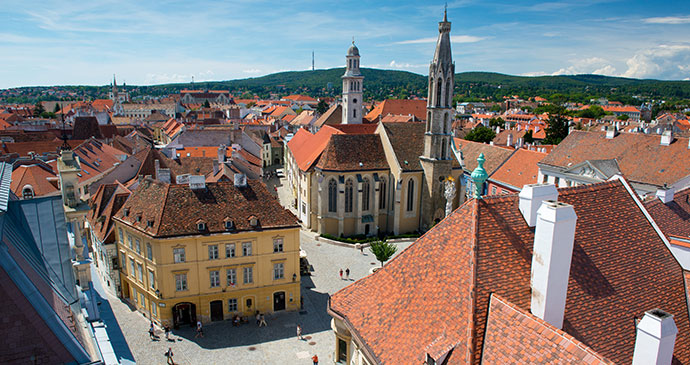
Sopron
Heck, we love this place. We’re sops to its architecture, its sense of past times in Fotér, its museums and pubs and restaurants, its very proximity to the lungs of the Lovér Hills and Lake Ferto. We even love its title, ‘Most Faithful City’ (Civitas Fidelissima), a reference to a post-Trianon referendum of 1921 when its citizens elected to remain part of Hungary rather than be subsumed into Austria. Beautiful and constant: what more could one ask?
The country’s westernmost city – pushing a bulge of border into Austria up to the foothills of the Alps – was settled first by the Celts and then the Romans, who called the place Scarbantia and thrived on the trade route known as the ‘Amber Road’ running between the Baltic Sea and the Adriatic. When the Magyars came they named it ‘Suprun’ after a contemporary county ruler, and merchants flourished throughout the medieval period. Unlike so much of the architecture further east, what was built here stayed built for the town remained untouched by Mongols and Turks. The slings and arrows of World War II left more considerable marks, but a committed programme of restoration put Sopron’s houses in order – a programme that was deservedly rewarded with the Europa Award for preservation in 1975.
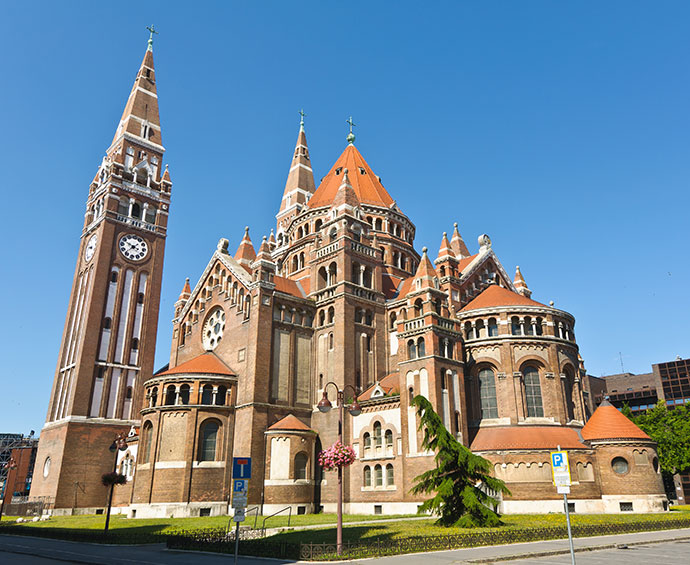
Szeged
Szeged rivals any city in Hungary, and is a thriving rebuttal to those who view the Great Plain as an architectural and cultural wasteland. On the map, its layout – cut through by the Tisza and ringed by inner and outer semi-circular boulevards – bears a passing resemblance to the eastern side of Budapest, and in some ways it can hold its own in such exalted company. In the aftermath of destruction, the city aimed to reinvent itself as the most harmonious provincial settlement in the country. It carefully crafted its public spaces, and each of the squares has a character all its own: the green Széchenyi tér honours greats of the past; Klauzál tér cultivates an atmosphere of theatre and performance, studded with statues of harlequins and street artists (and is, appropriately, the place where Kossuth gave his last public ‘performance’); Dóm tér is more austere, institutional and ‘Victorian’, reflecting its academic and religious heritage (although revellers invade during the Szeged Festival); Aradi vértanúk tere commemorates the 13 Martyrs of Arad, executed after defeat in the 1848–49 War of Independence. The result is a dynamic blend of significant past and carnivalesque present, a city whose spaces value both the contemplation of broad historical perspective and the escapist, bustling act of the here and now. There are decent restaurants, theatres and nightclubs, a nationally renowned opera, several universities, and one of the country’s best cathedrals. If one were to be ultra picky, it could be said that the city is light on heavyweight museums, but in every other way Szeged shines bright.
Around 15km from the Serbian border, Szeged sits just below the confluence of the Tisza and Maros rivers and during the early medieval period was a distribution centre for salt shipments brought on the Maros from Transylvania. Szeged was traditionally favoured by Hungarian monarchs, and flourished as a result. Its growth was inevitably stunted between 1543 and 1686 under Turkish occupation, although it represented the centre of the sultan’s lands and came under his protection. The real setback came a couple of centuries later. During the night of 12 March 1879 the city was engulfed by floodwater from the Tisza. Morning revealed the horrible extent of the damage: 95% of the buildings – 5,700 of the 6,000 – had been wiped away. A massive programme of reconstruction followed, bold Eclectic and Art-Nouveau architecture and avenues emerging from the muddy slush; sections of the Great Boulevard bear the names of European cities (such as Vienna, Paris and London) that aided the recovery. Szeged went from strength to strength, becoming a centre of textiles, salami production and paprika growing, and one of Hungary’s leading university cities. It is now the economic, cultural and academic capital of the Southern Plain.
Szentendre
Szentendre (St Andrew), bustling and touristy, is the first town of the Danube Bend, 19km north of Budapest. There was an influx of Serb refugees fleeing the Turks in the 14th century and, after depopulation during the occupation, another surge during the 17th century when Hungary was freed of Ottoman shackles but fighting still raged in the Balkans. Wooden buildings were replaced with stone ones, and Szentendre became the ecclesiastical centre for the diaspora Serb Orthodox Church; four remain of the several temples they built during their time here, each named after the region from which their congregation originated. The citizens were farmers and vintners, but many left after phylloxera and floods hit the area in the 19th century, and those who stayed replaced the vines with fruit orchards. Only a dozen or so Serbian families remain now, but the cosmopolitan legacy is reinforced by the modern flood of visitors from the capital.
The sun smiles on Szentendre, and artists are attracted like moths to its favourable light. In the 1920s an artists’ colony was established, and many continue to paint the town red. You can admire their handiwork in the seeming myriad of galleries, many ensconced in beautiful old town houses. Szentendre’s virtues give rise to its faults: you’ll barely scratch the rich surface of the art on a day trip, you’ll need to jostle with many others in the museums during summer months, and the cheerfully coloured buildings are too often occupied by fleecers, whose tat laminates rather than celebrates Hungarian culture. However, such qualms aside, there are few livelier places beyond the capital to enjoy the national artistic output, go shopping or stroll along winding alleys and the Danube banks.
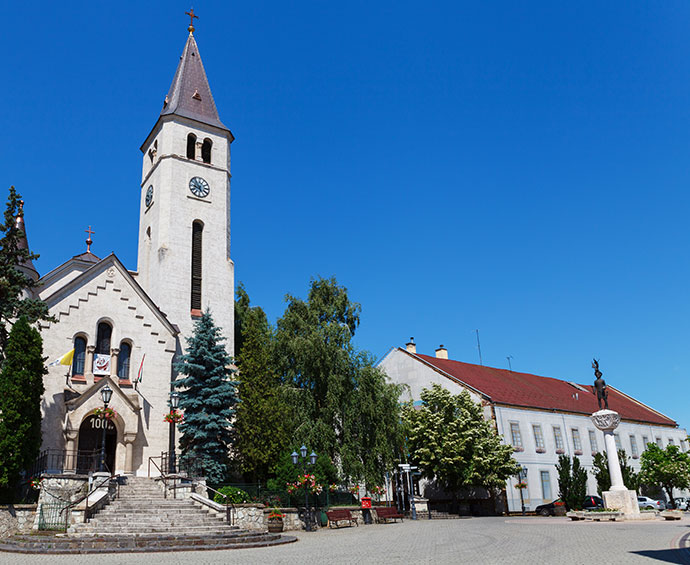
Tokaj
The statue of a naked Bacchanalian reveller in the centre is a prominent clue; a registered ‘International Town of Vine and Wine’, Tokaj is all about grapes and glasses. It is ‘capital’ of the Tokaj-Hegyalja (Tokaj Foothills) region, where the country’s most-lauded wine is produced.
The quality nose-dived with the mass production typical of the socialist market economy, but since 1991 private estates have re-emerged in place of the massive state-owned factories. Tokaj is just one of almost 30 wine towns in the area; it’s pretty enough, but wine is the religion here, and teetotallers will find little else to occupy their time.
Kecskemét
Equidistant from the Danube and the Tisza, Kecskemét is the principal town of Bács-Kiskun County. Kecske means ‘goat’ in Hungarian, and it is said this derives from the peculiar practice of the 13th-century bishop in presenting an animal to each convert to Christianity. History does not record how successful he was in appealing to them with the Father, the Son and a holy goat … Youthful in feel, architecturally adventurous in look, it isn’t hard to see what people like about Kecskemét. Once you’ve accustomed yourself to what at first feels a confusing centre – a merging cluster of squares – it’s worth putting aside a couple of days rather than hours to gape at some beautiful buildings, peruse a good selection of museums, shop from a decent range of boutiques and eat in some above-average restaurants. Kecskemét will keep you busy.
Kecskemét was a prosperous market town by the 15th century, and its layout – surrounded by a belt of farmsteads that give way to gardens and orchards – is typical of such settlements on the Great Plain. It suffered less than most during the Ottoman occupation, governed as it was directly by the sultan and enjoying his protection from the Turkish officers that intimidated and exploited the unfortunate towns that fell under their administration. Turning in earnest to viniculture in the 19th century, the citizens were fortunate once more when the rampant phylloxera louse decided it disliked the area’s sandy soil. The luck ran out in 1911 when an earthquake caused severe damage. ‘Twas but a temporary set back; today the town rivals Szeged and Debrecen as the region’s major educational and cultural player, and its apricot orchards yield renowned, throaty bottles of brandy (barackpálinka).
Winning wines
What should you plump for with dinner? Aged in networks of mouldclad cellars, Tokaji Aszú is long-lived and nectar sweet, with a volcanic mineral edge. It was favoured by Europe’s royal houses, and Louis XIV declared it ‘the king of wines, the wine of kings’ – which must have had the marketing people gleefully rubbing their hands.
Queen Victoria was presented each birthday with 12 bottles to mark each year of her life, receiving over 900 at the last count. It suffered under the state economy, but is back to its freshest and fruitiest.
Aszú is created from grapes affected by noble rot, and the number of hods (puttonyos) of such grapes added to a dry base wine determines the wine’s sweetness.
Most is produced at levels of between three and six puttonyos, with Aszú Esszencia sweeter still. Top recent vintages were 1996, 2000, 2002 and 2006, while those of 1993 and 1999 are judged to be classics. Dry Tokaji wines are also available – look out for those of 2000 and 2002 – but more readily acclaimed are the light and young-drinking whites from Lake Balaton (especially the Olaszrizling of Badacsony).
If you fancy something bubbly, the country’s main sparkling wine (pezsgő) is the relatively inexpensive Törley champagne. It’s produced by Hungary’s largest wine company, Hungarovin, and compares favourably with versions from New World countries. Bull’s Blood (Bikavér) derives its name from the period of Turkish occupation; the sober Ottomans thought that their opponents were made brave by consuming flagons of animal blood, when the Hungarians were actually more sensibly seeking Dutch courage in flagons of red wine.
Moves are under way to protect Bull’s Blood, which became synonymous with a Hungarian product ruined by commercialism, but its definition remains loose – simply encompassing ‘quality’ blended red wine from Szekszárd or Eger. One problem is that large companies continue to cling to its potential as a brand, looking enviously at the success of Australian Rosemount or Jacob’s Creek.
A leading firm even attempted to spark success by replacing its bull’s head logo with a rather Spanish-looking matador. Stick to bottles from small producers who take time over the product rather than the branding and you’ll find some excellent wines. Alternatively, reds from Villány are expressive, full-bodied and rightly rated.
Related books
For more information, see our guide to Hungary:
Related articles
From boiling lakes to vast alpine bodies of water, these are our favourite lakes from around the world.
There’s not a hot cross bun in sight!
Look at the stars, look how they shine for you.
Here’s how to make the most of the Hungarian capital in a weekend.
